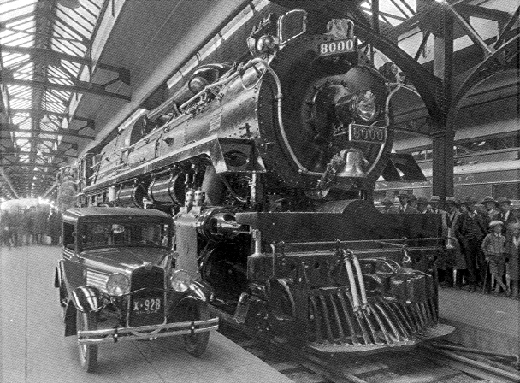 |
Summer 2006
|
In the Steam Era, Bigger Was Not
Always
Better
STEEL
WHEELS by Corporate Historian Emeritus Jonathan Hanna

The experimental behemoth on
display in Montreal's Windsor Station.
We've all heard, and some of us even believe, that bigger
is better.
The CPR has, on occasion, subscribed to the belief - building or buying some big and brutish steam locomotives. CPR's
biggest locomotive ever was a prototype multi-pressure steam locomotive. It was a
"home-made" locomotive built at the beginning of the Great Depression in the Company's Angus
Shops, in Montreal - Class T4a 2-10-4 locomotive No. 8000.
It seemed like a bigger and better idea at the time. But ultimately, the trouble and expense of running the
multi-pressure locomotive sealed its fate. All that was left was the legacy: No. 8000's
locomotive and tender were the longest, heaviest, and most powerful (without the help of a booster) on the CPR. Just
nine inches shy of 100 feet, the loaded locomotive and tender tipped the scales at almost 800,000 lbs. And No. 8000
produced 90,000 lbs. of tractive effort. Other 2-10-4 CPR steam locomotives needed a
trailing-truck booster to even come close to that massive amount of hauling power.
British-born locomotive chief, Henry Blaine Bowen, was in search of a more efficient steam locomotive
when he landed the top CPR motive power job in 1928. By then the railway had finished dabbling in compound locomotive
technology. Compound locomotives, with high and low-pressure cylinders, were seen as a way of increasing
efficiency, but CPR settled for super heating.
Bowen introduced a whole slew of locomotive innovations to CPR during his 21-year tenure as chief
mechanical officer, including diesel-electric power - although, he wasn't a fan and thought diesels were
just a passing fad.
Bowen knew multi-pressure locomotives could increase efficiencies. So he created a monster - CPR
locomotive No. 8000. Water and fuel consumption improved as much as 25 percent. But the locomotive was just too fussy
and complicated. Most superheated CPR locomotives had a single boiler with 275 psi of pressure. No. 8000 had three
boilers - a low-pressure boiler rated at 250 psi; a high-pressure boiler at 850 psi; and a
closed-circuit boiler, built right inside the firebox, rated at an astounding 1,350 psi. Some tests even
pushed the pressure up to 1,600 psi. And to complicate things, No. 8000 had three cylinders instead of the usual two.
A third cylinder hidden under the smokebox was coupled by a crank to the second set of driving wheels.
The behemoth rolled out of CPR's Angus Shops in Montreal on 29 May 1931. After initial tests around
Montreal, No. 8000 headed for Revelstoke in September. It spent the next five years out west, one-third
of its time in the shops! Taken out of service in September 1936, No. 8000 went back to Montreal and was scrapped in
December 1940.
| |
Vital
Statistics
|
Locomotive Number
|
8000
|
Class
|
T4a
|
Builder
|
CPR Angus Shops
|
Outshopped
|
29 May 1931
|
Type
|
Selkirk
|
Wheel arrangement
|
2-10-4
|
Tractive effort
|
90,000 lbs (40,770 Kg)
|
Driving wheel diameter
|
63 in. (160 cm)
|
Extreme length
|
99 ft. 3 in. (30.1 m)
|
Extreme Width
|
10 ft. (3.1 m)
|
Extreme Height
|
15 ft. 6 in. (4.7 m)
|
Weight loaded
|
797,420 lbs. (361,230 Kg)
|
This Canadian Pacific Spanner article
is copyright 2006 by the Canadian Pacific Railway and is reprinted here with their
permission. All photographs, logos, and trademarks are the property of the Canadian Pacific Railway
Company.
|